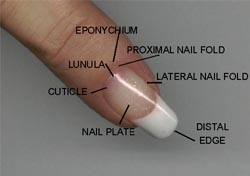Nails grow at the end of fingers and toes, primarily serve as a protection, despite the current trends of decorating them with different paintings and colourings for cosmetic purposes.
The many different shapes and status of the nails actually tell us quite a lot about the internal conditions of our body. If you find usual changes in colour, shapes, smoothness, and separation from the nail beds, you should consult a dermatologist.
The main structure of the nail is the nail plate, which is a flat piece of dead protein called keratin, and is formed by flattening of the keratinocytes as they divide, migrate upwards and die. The nail plate is half-transparent.

The only living part is the nail root called the matrix, which is delineated by the ‘half moon’ lunula that marks its margin. The matrix extends into and under the proximal nail fold, which is normally tightly adhered to the nail plate by the cuticle to prevent entry of water.
About one quarter of the nail is beneath the proximal nail fold and the exposed part is attached to the nail bed, which has a profuse blood supply and provide the nail its pink colour.
The tip of the nail is not attached to the nail bed. This part is yellowish-white colour and this is where we trim our nails. In some diseases, the separation begins from here and extends into the nail bed.
The nail fold is normally attached to the nail plate and is watertight. When the nail fold is detached, its waterproof properties are lost allowing various organisms and irritants to wash under it, and potentially set up infection or irritation in the nail bed and matrix. The nail fold swells in this situation and is further detached, and a vicious circle is set up, and may potentially damage the whole nail.
A typical example is Candida, which enter via this route. Other nail fungal infections, on the other hands, start usually from the free ends and the lateral sides. To protect the integrity of the nail fold, you have to prevent wetting the hands, or coming into contact with some irritants, for a long period.
The nail grows only slowly. It normally takes 5 - 6 months for the fingernails, and 9 - 12 months for the toenails, to grow out. The grow rate may be different in different nails, even in the same hand or foot.
During an episode of severe illness, the nails will grow a lot slower, until the recovery. The nail grown during this period forms a separation line from the part of nail before the illness. On the contrary, the nails in psoriasis grow a lot faster.

